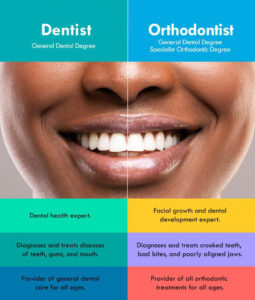There are more differences than similarities. An ORTHODONTISTrequires additional schooling as a dental specialty; the situation is similar to a doctor who obtains additional schooling to become a surgeon. Another difference is that orthodontists specialize in helping patients with the alignment of their teeth, improving their bite, or fitting them for CORRECTIVE BRACES and devices. If a patient has an overbite, a dentist will refer him or her to an orthodontist.

WHAT DO DENTISTS DO ?
Dentists are doctors of oral health. Typically, dentists go to college for a pre-dentistry or pre-medical degree before going on to a graduate school of dentistry.Like all doctors, dentists are required to be extensively trained in their practice before becoming certified. About 80 percent of dentists practice what’s known as general dentistry. Certified dentists can diagnose and treat oral health conditions of your teeth, gums, tongue, and mouth. They’re also able to clean your teeth, but dental hygienists usually take care of that.
Dentists provide the following care:
- conduct and interpret dental X-rays
- fill cavities
- repair cracked teeth
- promote oral health and oral hygiene
- fill and bond teeth
- treat gum disease, such as gingivitis
- prescribe treatment, including prescription drugs, for oral health conditions
- whiten teeth
- install crowns or veneers
- oversee the development of children’s teeth
- perform oral surgery
WHAT DO ORTHODONTISTS DO?
Orthodontists are also doctors of oral health. Technically, they’re a kind of dentist with a specialty in tooth and jaw alignment. Certified orthodontists are trained to diagnose and treat oral health conditions of your teeth, gums, and mouth. But mostly, orthodontists focus on making sure your teeth and jaw are set correctly.
Orthodontists do the following:
- supervise facial growth (jawline and bite) in children
- diagnose and treat misaligned teeth and jaws (malocclusion)
- create a treatment plan that includes braces and retainers
- perform teeth straightening surgery
- install dental appliances, such as braces, palatal expanders, orthodontic headgear, or Herbst appliances
